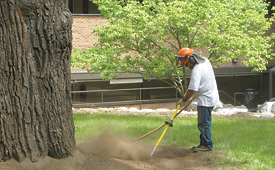In late March last year, grounds crews were cutting grass a full month ahead of schedule during a season of record-setting warm temperatures.
This year, grounds supervisors say the change of seasons basically is back to normal as crews focus on meeting President Mary Sue Coleman’s initiative to reduce landscape chemical use by 40 percent by 2025.

Chris Pargoff, a certified master arborist and temporary employee on the U-M forestry crew, airspades around a historic oak tree at the Stephen M. Ross School of Business’ Executive Residence. Airspading is a technique in which air is blown into the ground around trees to relieve soil compaction. Photo by Marvin Pettway, Grounds Services.
“We’re switching some of our fertilizer to organic fertilizer in some key areas, including the Diag and Ingalls Mall,” said Rob Doletzky, senior supervisor of turf, irrigation and grounds maintenance.
These applications will be followed one week later with an application of dry compost or liquid “compost tea” created on North Campus. “We want to apply it when the grass starts growing,” he said.
Doletzky said the beneficial organisms within the compost eat the protein material in the organic fertilizer.
“That produces nitrogen that will feed the plants or the grass,” he said. “The idea to is to create these environmentally friendly green zones or sustainability zones. We have tested this over the last couple of years and are ready to expand to larger areas.”
Crews also are trying a new environmentally friendly iron chelate product to replace broadleaf herbicides for lawns throughout the Diag and Ingalls Mall. As budgets allow, they hope to expand the use of this product to other parts of campus.
“Our crews are constantly looking for ways to implement environmentally friendly methods or products to maintain aesthetically pleasing lawns while keeping in line with our budget,” Doletzky said.
In the past week, much work was devoted to the annual replacement of plows and rotary brooms used for snow removal with mowing decks on about 20 pieces of equipment that are used for both tasks.
This week, Doletzky said, crews will start turning on irrigation system mainlines to make sure no breaks occurred over the winter. They need to work properly once the warmer, dry weather approaches. They also are raking out planting beds, cleaning hardscape areas and seeding damaged or thin areas of lawns.
The contingent of 45 full-time grounds crew members grows to 120 as warmer weather approaches, as temporary employees, mainly students, join the ranks.
On April 6-7 on North Campus, crews conducted a controlled burn of 16 woodlot acres to manage invasive species. Marvin Pettway, supervisor of forestry and horticulture maintenance, said the burn stunts the growth of, but doesn’t kill, invasive buckthorn, Asian honeysuckle and garlic mustard. These invasive plants do not provide nourishment for local insects.
“You want to see what works effectively for your native insects. They feed the birds up the food chain, and help soil and air quality and that benefits humans,” Pettway said.
The burn also supports the growth of native oak, hickory and black cherry trees while retarding the growth of invasive species to put them at a disadvantage. Meanwhile, the burn does not affect ground-dwelling wildlife, while deer “just walk away” from it, he said.
Also this time of year, forestry and horticulture maintenance crews inspect storm basins on North Campus as a part of their vegetation-management duties.
“We’re looking for sedimentation buildup. You also want to note any kind of slope erosion to the overall basin, and what kind of vegetation is growing there,” including invasive grasses that can also be managed with burns, Pettway said. These inspections continue into May.
Pettway said in coming weeks crews also will use equipment to blow air into the ground around trees, a procedure called airspading. This relieves soil compaction so roots have better access to water, nutrients and air.
Another initiative in coming weeks is to continue to collect information on tree locations, to add to the Geographic Information Systems inventory of buildings and infrastructure. This creates more complete data to access, when it comes time to dig at certain locations or perform other work.

